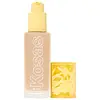Mac Cosmetics Studio Radiance Face and Body Foundation Versus Kosas Revealer Skin-Improving Foundation SPF 25
What's inside
What's inside
 Key Ingredients
Key Ingredients

 Benefits
Benefits

 Concerns
Concerns

 Ingredients Side-by-side
Ingredients Side-by-side

Water
Skin ConditioningDimethicone
EmollientHydrogenated Polyisobutene
EmollientButylene Glycol
HumectantVp/Hexadecene Copolymer
Stearic Acid
CleansingPhenyl Trimethicone
Skin ConditioningPolyglyceryl-3 Diisostearate
EmulsifyingEthylhexyl Hydroxystearate
EmollientVp/Eicosene Copolymer
Talc
AbrasiveTrimethylsiloxysilicate
EmollientTocopherol
AntioxidantTocopheryl Acetate
AntioxidantFusanus Spicatus Wood Oil
MaskingCitrus Aurantium Dulcis Peel Oil
MaskingMagnesium Aluminum Silicate
AbsorbentTriethanolamine
BufferingPolysorbate 20
EmulsifyingXanthan Gum
EmulsifyingCetyl Alcohol
EmollientFarnesol
PerfumingDisodium EDTA
Phenoxyethanol
PreservativeChlorphenesin
AntimicrobialMica
Cosmetic ColorantCI 77891
Cosmetic ColorantCI 77491
Cosmetic ColorantCI 77492
Cosmetic ColorantCI 77499
Cosmetic ColorantWater, Dimethicone, Hydrogenated Polyisobutene, Butylene Glycol, Vp/Hexadecene Copolymer, Stearic Acid, Phenyl Trimethicone, Polyglyceryl-3 Diisostearate, Ethylhexyl Hydroxystearate, Vp/Eicosene Copolymer, Talc, Trimethylsiloxysilicate, Tocopherol, Tocopheryl Acetate, Fusanus Spicatus Wood Oil, Citrus Aurantium Dulcis Peel Oil, Magnesium Aluminum Silicate, Triethanolamine, Polysorbate 20, Xanthan Gum, Cetyl Alcohol, Farnesol, Disodium EDTA, Phenoxyethanol, Chlorphenesin, Mica, CI 77891, CI 77491, CI 77492, CI 77499
Zinc Oxide 7.5%
Cosmetic ColorantWater
Skin ConditioningEthylhexyl Olivate
Skin ConditioningOctyldodecanol
EmollientUndecane
EmollientPolyglyceryl-2 Dipolyhydroxystearate
Skin ConditioningGlycerin
HumectantMica
Cosmetic ColorantCalcium Sodium Borosilicate
Caprylic/Capric Triglyceride
MaskingNiacinamide
SmoothingPolyglyceryl-3 Diisostearate
EmulsifyingGalactoarabinan
Tridecane
PerfumingPropanediol
SolventCetyl Alcohol
EmollientGlyceryl Oleate
EmollientSodium Hyaluronate
HumectantPalmitoyl Tripeptide-5
Skin ConditioningPanthenol
Skin ConditioningSqualane
EmollientCaffeine
Skin ConditioningArnica Montana Flower Extract
MaskingArtemisia Capillaris Flower Extract
Skin ConditioningEthyl Ferulate
AntioxidantSodium Gluconate
Skin ConditioningPolyhydroxystearic Acid
EmulsifyingMaltodextrin
AbsorbentPentylene Glycol
Skin ConditioningLecithin
EmollientHydrogenated Lecithin
EmulsifyingTocopherol
AntioxidantPhenethyl Alcohol
MaskingCI 77891
Cosmetic ColorantIron Oxides
Zinc Oxide 7.5%, Water, Ethylhexyl Olivate, Octyldodecanol, Undecane, Polyglyceryl-2 Dipolyhydroxystearate, Glycerin, Mica, Calcium Sodium Borosilicate, Caprylic/Capric Triglyceride, Niacinamide, Polyglyceryl-3 Diisostearate, Galactoarabinan, Tridecane, Propanediol, Cetyl Alcohol, Glyceryl Oleate, Sodium Hyaluronate, Palmitoyl Tripeptide-5, Panthenol, Squalane, Caffeine, Arnica Montana Flower Extract, Artemisia Capillaris Flower Extract, Ethyl Ferulate, Sodium Gluconate, Polyhydroxystearic Acid, Maltodextrin, Pentylene Glycol, Lecithin, Hydrogenated Lecithin, Tocopherol, Phenethyl Alcohol, CI 77891, Iron Oxides
Ingredients Explained
These ingredients are found in both products.
Ingredients higher up in an ingredient list are typically present in a larger amount.
Cetyl Alcohol is a fatty alcohol. Fatty Alcohols are most often used as an emollient or to thicken a product.
Its main roles are:
Though it has "alcohol" in the name, it is not related to denatured alcohol or ethyl alcohol.
The FDA allows products labeled "alcohol-free" to have fatty alcohols.
Learn more about Cetyl AlcoholCi 77891 is a white pigment from Titanium dioxide. It is naturally found in minerals such as rutile and ilmenite.
It's main function is to add a white color to cosmetics. It can also be mixed with other colors to create different shades.
Ci 77891 is commonly found in sunscreens due to its ability to block UV rays.
Learn more about CI 77891Mica is a naturally occurring mineral used to add shimmer and color in cosmetics. It can also help improve the texture of a product or give it an opaque, white/silver color.
Serecite is the name for very fine but ragged grains of mica.
This ingredient is often coated with metal oxides like titanium dioxide. Trace amounts of heavy metals may be found in mica, but these metals are not harmful in our personal products.
Mica has been used since prehistoric times throughout the world. Ancient Egyptian, Indian, Greek, Roman, Aztec, and Chinese civilizations have used mica.
Learn more about MicaPolyglyceryl-3 Diisostearate is an emulsifer and emollient. It comes from Isostearic Acid and Polyglycerin-3.
As an emulsifier, it helps stabilize products by preventing oils and water from separating.
This ingredient may not be Malassezia folliculitis, or fungal acne safe.
Learn more about Polyglyceryl-3 DiisostearateTocopherol (also known as Vitamin E) is a common antioxidant used to help protect the skin from free-radicals and strengthen the skin barrier. It's also fat soluble - this means our skin is great at absorbing it.
Vitamin E also helps keep your natural skin lipids healthy. Your lipid skin barrier naturally consists of lipids, ceramides, and fatty acids. Vitamin E offers extra protection for your skin’s lipid barrier, keeping your skin healthy and nourished.
Another benefit is a bit of UV protection. Vitamin E helps reduce the damage caused by UVB rays. (It should not replace your sunscreen). Combining it with Vitamin C can decrease sunburned cells and hyperpigmentation after UV exposure.
You might have noticed Vitamin E + C often paired together. This is because it is great at stabilizing Vitamin C. Using the two together helps increase the effectiveness of both ingredients.
There are often claims that Vitamin E can reduce/prevent scarring, but these claims haven't been confirmed by scientific research.
Learn more about TocopherolWater. It's the most common cosmetic ingredient of all. You'll usually see it at the top of ingredient lists, meaning that it makes up the largest part of the product.
So why is it so popular? Water most often acts as a solvent - this means that it helps dissolve other ingredients into the formulation.
You'll also recognize water as that liquid we all need to stay alive. If you see this, drink a glass of water. Stay hydrated!
Learn more about Water